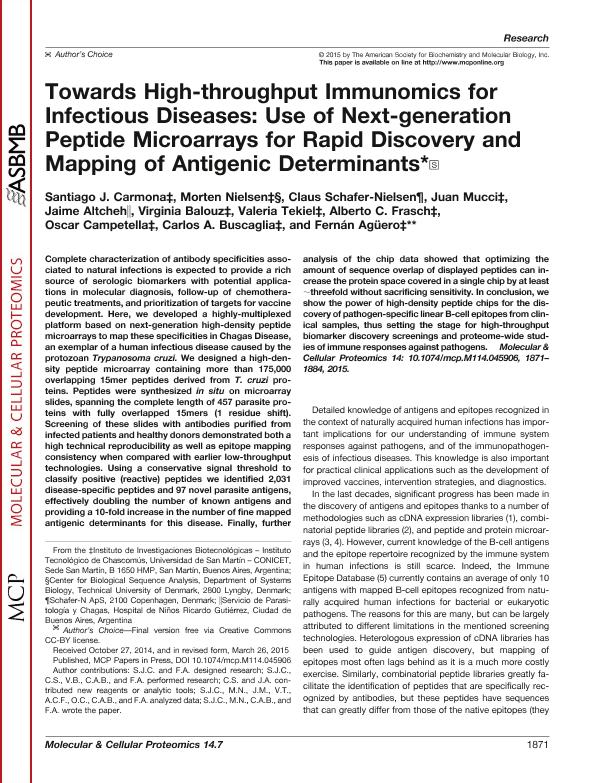Artículo
Towards High-throughput Immunomics for Infectious Diseases: Use of Next-generation Peptide Microarrays for Rapid Discovery and Mapping of Antigenic Determinants
Carmona, Santiago Javier ; Nielsen, Morten
; Nielsen, Morten ; Schafer Nielsen, Morten; Mucci, Juan Sebastián
; Schafer Nielsen, Morten; Mucci, Juan Sebastián ; Altech, J; Balouz, Virginia
; Altech, J; Balouz, Virginia ; Tekiel, Valeria Sonia
; Tekiel, Valeria Sonia ; Frasch, Alberto Carlos C.
; Frasch, Alberto Carlos C. ; Campetella, Oscar Eduardo
; Campetella, Oscar Eduardo ; Buscaglia, Carlos Andres
; Buscaglia, Carlos Andres ; Aguero, Fernan
; Aguero, Fernan
 ; Nielsen, Morten
; Nielsen, Morten ; Schafer Nielsen, Morten; Mucci, Juan Sebastián
; Schafer Nielsen, Morten; Mucci, Juan Sebastián ; Altech, J; Balouz, Virginia
; Altech, J; Balouz, Virginia ; Tekiel, Valeria Sonia
; Tekiel, Valeria Sonia ; Frasch, Alberto Carlos C.
; Frasch, Alberto Carlos C. ; Campetella, Oscar Eduardo
; Campetella, Oscar Eduardo ; Buscaglia, Carlos Andres
; Buscaglia, Carlos Andres ; Aguero, Fernan
; Aguero, Fernan
Fecha de publicación:
04/2015
Editorial:
American Society for Biochemistry and Molecular Biology
Revista:
Molecular & Cellular Proteomics
ISSN:
1535-9476
Idioma:
Inglés
Tipo de recurso:
Artículo publicado
Clasificación temática:
Resumen
Complete characterization of antibody specificities associated to natural infections is expected to provide a rich source of serologic biomarkers with potential applications in molecular diagnosis, follow-up of chemotherapeutic treatments, and prioritization of targets for vaccine development. Here, we developed a highly-multiplexed platform based on next-generation high-density peptide microarrays to map these specificities in Chagas Disease, an exemplar of a human infectious disease caused by the protozoan Trypanosoma cruzi. We designed a high-density peptide microarray containing more than 175,000 overlapping 15mer peptides derived from T. cruzi proteins. Peptides were synthesized in situ on microarray slides, spanning the complete length of 457 parasite proteins with fully overlapped 15mers (1 residue shift). Screening of these slides with antibodies purified from infected patients and healthy donors demonstrated both a high technical reproducibility as well as epitope mapping consistency when compared with earlier low-throughput technologies. Using a conservative signal threshold to classify positive (reactive) peptides we identified 2,031 disease-specific peptides and 97 novel parasite antigens, effectively doubling the number of known antigens and providing a tenfold increase in the number of fine mapped antigenic determinants for this disease. Finally, further analysis of the chip data showed that optimizing the amount of sequence overlap of displayed peptides can increase the protein space covered in a single chip by at least ~3 fold without sacrificing sensitivity. In conclusion, we show the power of high-density peptide chips for the discovery of pathogen-specific linear B-cell epitopes from clinical samples, thus setting the stage for high-throughput biomarker discovery screenings and proteome-wide studies of immune responses against pathogens.
Palabras clave:
High-Density Peptide Microarrays
,
Next-Generation Peptide Microarrays
,
Tiling Peptide Arrays
,
High-Throughput Serology Assays
,
Antigen Discovery
,
Epitope Discovery
,
B-Cell Epitopes
,
Antigenic Determinants
,
Immune Responses
,
Humoral Responses
,
Chronic Infections
,
Human Infectious Diseases
,
Chagas Disease
,
Trypanosoma Cruzi
Archivos asociados
Licencia
Identificadores
Colecciones
Articulos(IIB-INTECH)
Articulos de INST.DE INVEST.BIOTECNOLOGICAS - INSTITUTO TECNOLOGICO CHASCOMUS
Articulos de INST.DE INVEST.BIOTECNOLOGICAS - INSTITUTO TECNOLOGICO CHASCOMUS
Citación
Carmona, Santiago Javier; Nielsen, Morten; Schafer Nielsen, Morten; Mucci, Juan Sebastián; Altech, J; et al.; Towards High-throughput Immunomics for Infectious Diseases: Use of Next-generation Peptide Microarrays for Rapid Discovery and Mapping of Antigenic Determinants; American Society for Biochemistry and Molecular Biology; Molecular & Cellular Proteomics; 14; 4-2015; 1871-1884
Compartir
Altmétricas



